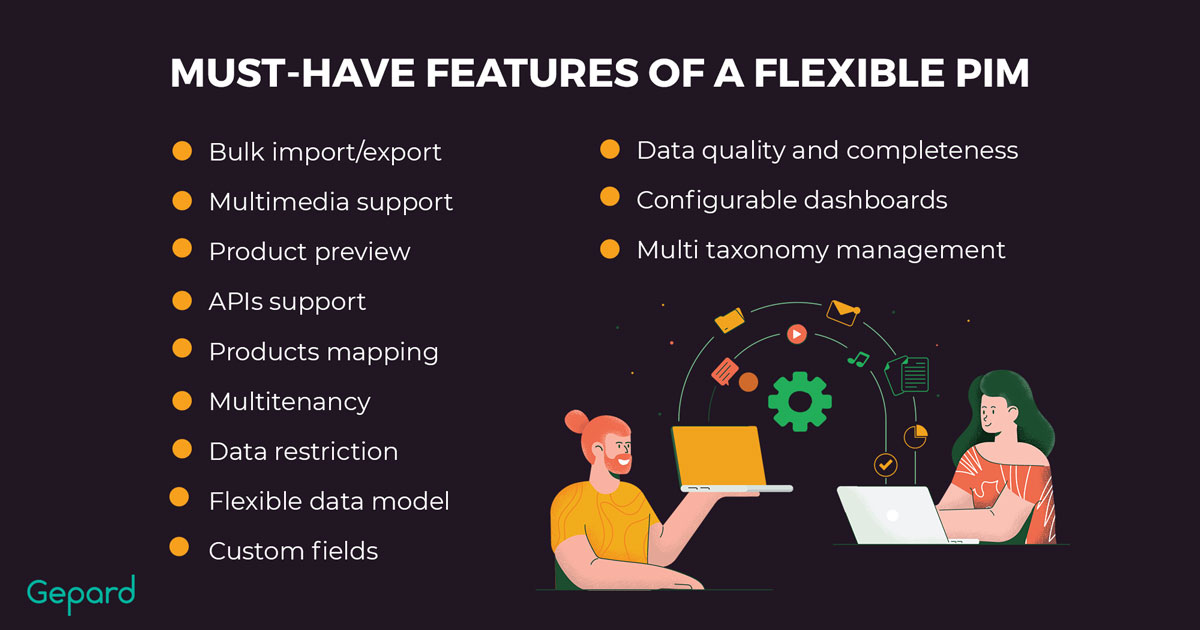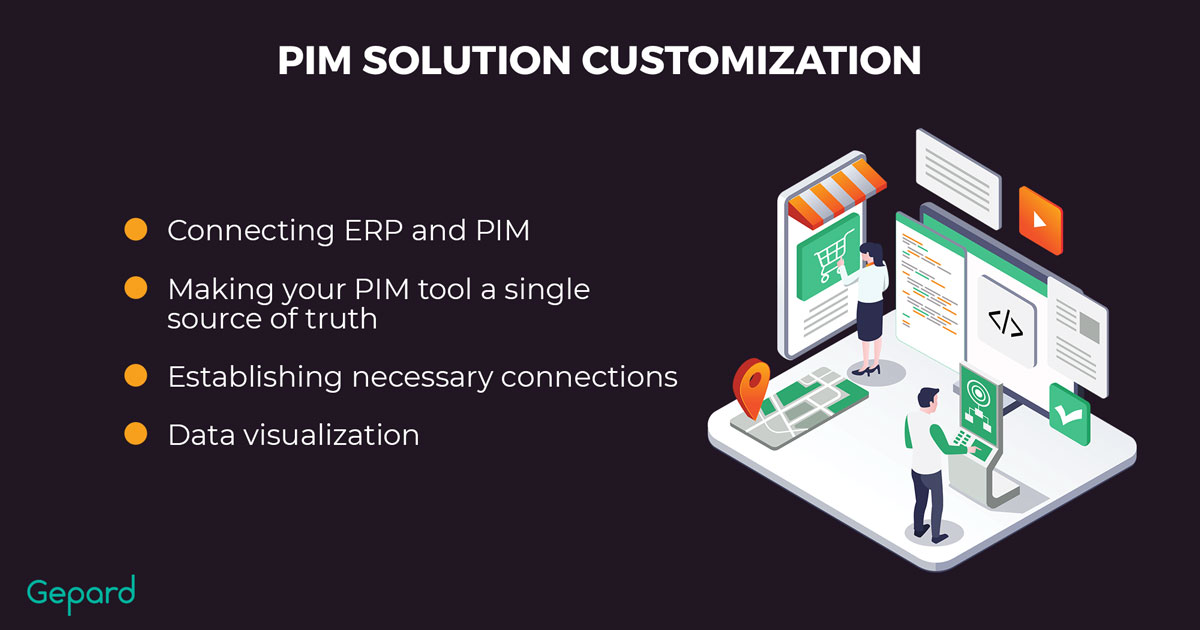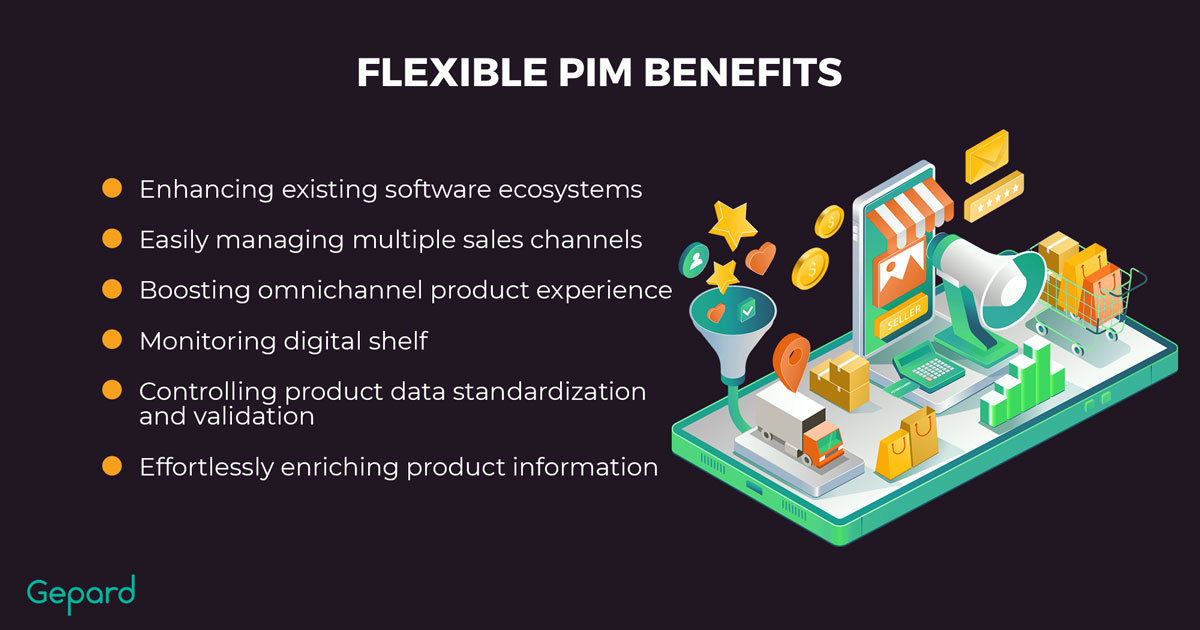PIM As An Ultimate Data Quality Booster. How Flexible Is Your PIM Solution?
An ultimately flexible PIM solution is the foundation of steadily efficient data management, constantly improving business operations and streamlined customer experience as a result. A timely adopted product information management system (PIMS) becomes your trusty data hub that gathers all essential information in one place and lets you easily distribute it across sales channels.
This type of centralized product management approach eliminates burdens, smoothes out productivity, and saves precious time. But what makes a truly flexible PIM tool, the bottom-line benefits of which are clearly reflected in higher sales? Let’s figure it out.
What Is A Flexible PIM Solution?
Flexible PIM Solution Functionality – Must-Have Features
Only a rich set of relevant features can make your PIM tool highly flexible. Let’s take a look at some major must-haves.
Bulk Import/Export
The ability to bulk import and export assets often comes as a paid extension outside of the standard PIM functionality scope. And only a truly flexible PIM software solution provides this feature out of the box. It should allow you to automate bulk operations through an established API or FTP connection, or upload files in supported formats manually (the most common formats are CSV, XLS, XML, and JSON).
Multimedia Support
Many existing product information management systems support only the most basic multimedia data inputs – images of certain formats. And their upload extent can be quite limited in basic software plans. A versatile solution that packs long-term benefits, on the other hand, supports all sorts of media files, including images, PDF files, videos, attachments, etc.
Product Preview
Previewing solutions in production is another relevant, workflow-boosting ability a flexible system should offer. It enables you to see how exactly a product would look after it is posted to a certain channel before actually posting it. This gives you handy momentum to make all the necessary changes and polish out the product beforehand. So your potential PIM pick is a no-go if it doesn’t have this feature in-store or at least lets you request a product demo.
APIs Support
Various PIM solution providers may offer alternative tech approaches to PIM integration with third-party services, data sources, and extra tools. However, it is full-on support of APIs that makes your system versatile enough to boost sales without burning a hole in your pocket. On top of its above-mentioned bulk import/export gateway purpose, an out-of-the-box API should be configurable and open-ended enough to fit individual needs and custom integrations.
Products Mapping
Efficient mapping of products is vital to gaining a sharp and sturdy competitive edge. In particular, by mapping out essential target features and uses of a product and comparing them with the most relevant market solutions offered by competitors. Most existing PIMs either provide manual product mapping or support it as an extension or an additional separate function. A powerful platform, on the flip side, runs its own product mapping engine that is best managed by dedicated taxonomists that keep that engine optimized and efficient.
Read more about product taxonomy:
Multitenancy
Multiple user roles within a product information management system PIMS reinforces the security of data access and streamlines product management workflow by segmenting it according to specialist’s qualifications. Not everybody working on your project may need to access the core internal assets of the product. Specialized platforms commonly allow you to set up and define user roles manually. But the ultimate flexibility you are looking for lies, again, in the out-of-the-box availability of segmented user roles plus an ability to define new ones.
Data Restriction
This is a more common function throughout existing PIMs due to the initial focus of such systems on managing data. However, access to certain types of assets is usually restricted based on predefined user roles. So this feature is kind of bound to the above (a system with convenient user role segmentation should grant proper access restriction opportunities from the get-go).
Flexible Data Model
When it comes to versatile data management carried out by multiple entities within a centralized system, not only access to assets should be segmented and customized. Relationships between entities accessing those assets must be segmented accordingly. Not all product information management software solutions support this by default. A highly flexible solution, however, allows introducing and defining new entities within a tenant setup.

Custom Fields
Customization opportunities are essential to the PIM’s flexibility and dictate it in many ways. You should make sure that your solution of choice lets you add and define metadata categories however you like in order to describe assets the way you see them.
Data Quality And Completeness
The completeness and quality of data in production are paramount for obvious reasons (high-quality, consistent assets bring high sales and consistent user experience). Different platforms help you achieve high rates of data quality and completeness in different ways (while some solutions do not provide any related tools at all). The most common data validation options are reports, custom quality rules, completeness scores, and various paid extensions.
If you are looking for the ultimate software versatility, however, you need to get a wider range of not only data quality checkups but also initial data enrichment opportunities. For instance, ways to connect with data suppliers and/or content providers who would help manage the integrity of provided assets across the board.
Configurable Dashboards
Coming back to the extent of customization, your perfect PIM cannot be a fit-for-all solution. If it is a readymade solution, it needs to be customizable enough to really hit the spot in terms of specific business goals and tasks. For this, you need a solution with configurable dashboards that would enable your product managers to set up their PIM workplace and workflow individually.
Multi Taxonomy Management
Last but not least, a versatile PIM software solution enables segmented taxonomy, making the hierarchy of mapped-out product data categories clearer and much more accessible. This is a must-have feature that saves managers tons of time and helps keep all assets neat and well-structured.
Flexible PIM Solutions Use Cases
To help you understand the benefits of PIM in eCommerce, we’ve compiled a Use Case Table that showcases various use cases and how PIM can help improve data quality and eCommerce management. Check out the table below to learn how PIM can benefit your eCommerce business.
| Use Case | Description | Benefits of PIM |
| Omni-Channel Retail | Creating multi-domain product information management via different channels such as Amazon, eBay, and your own website | PIM helps ensure centralized product data is consistent across omni-channel retail, reducing errors and improving customer experience |
| Global Expansion | Expanding your eCommerce business to new countries and regions by providing multilingual product data | PIM can help manage translations, localizations, and compliance requirements for different markets, reducing errors and improving time-to-market |
| New Product Launch | Launching new products and SKUs | PIM can help streamline the product information creation process, ensuring accurate and complete information is available for marketing and sales efforts |
| Inventory Management | Managing inventory across multiple warehouses and locations | PIM can help track inventory levels and locations, reducing stockouts and improving order fulfillment |
| Product Information Enhancement | Enhancing product information with rich media such as images and videos | PIM can help manage and publish rich media assets, improving product visibility and customer engagement |
| Customer Data Integration | Integrating customer data into product catalog management | PIM can help personalize product information based on customer data, improving customer engagement and loyalty |
| SEO Optimization | Optimizing product information for search engines | PIM can help ensure product information is optimized for search engines, improving product visibility and search rankings |
| Regulatory Compliance | Ensuring compliance with regulations such as EPREL and PI Standard | PIM can help manage and track compliance requirements, reducing legal risks and improving customer trust |
PIM Solution Customization
We just cannot stress enough the importance of customization in PIM software solutions. By picking a system that is inherently customizable across most aspects, you achieve that proper level of flexibility for outstanding market results. To make it easier for you, here are four major aspects that should be customizable by default to let you set up a system’s powerhouse.
Connecting ERP and PIM
ERP systems tend to make up the backbone of daily operations in thousands of companies (especially those working in the eCommerce sector). Businesses use them to manage anything from finance and supply chain to logistics and human processes. Connecting an existing ERP solution to a PIM system results in the ultimate benefit of eliminating the common errors of manual data input and processing.
Raw product data acquired via ERP can be enriched with specialized tools and then distributed across required channels. This allows you to achieve harmonious collaborative performance where back-end and front-end operations are balanced out to give you
- Higher inventory management efficiency;
- Faster assets transfer;
- Fewer marketing inaccuracies.
All you need to do is properly sync up the performance of both systems while a built-in configurable API will help you handle all the extra integrations.
Making Your PIM Tool A Single Source Of Truth
While assets may be initially acquired via ERP or some other specialized system, it is important to edit and finalize it in a uniform environment. Painless product content management workflow can only be achieved when all involved specialists work with a single source of truth. This means that all dedicated managers work in a single space where they may neatly structure assets and easily assemble disparate data for streamlined results. This is more than possible with a flexible product information management solution in hand.
Establishing Necessary Connections
A versatile PIM system is an open-ended one. Once you connect your system to the data flow coming from ERP, you need to be able to establish connections with content providers, eCommerce marketplaces, repositories, and other sources. For this, make sure your system of choice supports configurable APIs and allows extensive integrations with other systems.
Data Visualization
Another important factor to keep customized and individualized is the way all the underlying data is visualized. Specialists must get an individually convenient view of all that is going on. For this, the above-mentioned configurable dashboards are a must. On top of that, make sure a range of visualization tools are available, like dynamic graphs and charts, heat maps, tables, etc.

How Flexible PIM Tool Empowers eCommerce Business Users
A versatile PIM software solution drives modern eCommerce in many ways by expanding marketing opportunities and streamlining eCommerce management. Here are some of the main benefits of flexible specialized software.
Enhancing Existing Software Ecosystems
Based on all the benefits and powers brought about by an efficient PIM system, we can safely say that your existing commercial software ecosystem is incomplete without one. Integrating with such a system, you pinpoint and reduce manual errors, and lower the overall complexity of data management, indulging in a range of resulting advantages.
Easily Managing Multiple Sales Channels
Connecting a range of sales channels within a single source of truth is the main forte of PIM solutions. Specialists get a unified way to publish product information across all relevant channels using familiar, individually customized tools.
Boosting Omnichannel Product Experience
Streamlined sales channel distribution of product content grants a higher level of overall product experience across channels. Thus, you can form a cohesive, well-integrated way potential customers perceive your product, and boost the general product data quality that will improve the interaction between the customer and your brand.
Read more about building a successful omnichannel strategy:
Monitoring Digital Shelf
Unified digital shelf monitoring and analytics help improve the way you keep track of the quality and completeness of assets flowing in from a range of sources. A specialized digital shelf centralizes your outlook, and overall data suppliers, helping make sure you receive the well-structured information you are paying for.
Centralized Product Data Standardization And Validation Controlling
In-depth validation of the product data quality eliminates expensive errors and helps make double sure that all the assets you wield are top-of-the-line. Data standardization, on top of that, can be automated to consolidate inputs coming from various channels flawlessly and optimize them in line with universal data standards. A flexible solution offers specialized tools for both processes.
Enriching Product Information Effortlessly
With a good fusion of reliable sources, automated data control opportunities, and extensive editing capacities, product data enrichment becomes effortless. A proper platform easily imports information, automatically optimizes it based on your requirements, allows multiple integrations for enriching it, and publishes it on all required channels.

Gepard PIM Tool Flexibility In Action
Gepard PIM, as a highly flexible and scalable PIM solution, offers a wide functionality that can be set up and customized for each specific user. Here are some of the adjustable Gepard features that make the work with product content more effective and versatile.
- Flexible data import/export. You can choose the method of bulk data import and export: either automatically via an established connection (API/FTP) or manually by uploading product information in supported data formats (CSV, XLSX, XML, JSON).
- Multimedia support. Gepard allows you to upload attachments, images, media files, PDFs, and more. It significantly increases your chances of creating compelling product content.
- Powerful product mapping engine. Gepard offers flexible transformation rules support and, even more – a team of taxonomists who perform mappings as a service.
- Data governance roles. There are four standard roles and there can be more added via the user interface.
- API connections. Apart from a standard API push, Gepard offers a configurable data import/export through API and allows you to integrate with a variety of eCommerce platforms, marketplaces, retailers, and content service providers.
- Data restriction. It’s possible for users to set up restricted access to data according to role-based data permission settings.
- Flexible data model & custom fields. This allows for introducing new entities within a tenant setup. Multitenancy is one of the important features of a flexible PIM solution.
In addition to all the mentioned features, the Gepard PIM users can set up a configurable dashboard and two factors authentication, which significantly increases the security of data within any business organization.
Flexible PIM Solution FAQ
Is It Possible To Adapt The PIM Tool For Retailer-Specific Content?
A highly flexible PIM tool enables product experience enhancement based on retailer-specific content for pinpointed results through custom connections, individualized workflows, automated data validation and syndication, and more.
How To Collect Product Content From Suppliers Without Using Spreadsheets?
Your PIM platform of choice should be easily integrated with third-party services of data suppliers and built-in data mapping algorithms that automate the process of asset collection and eliminates manual data formatting tasks. No spreadsheets are involved.
Do All PIM Solutions Offer Product Data Syndication Out Of The Box?
Not all PIM solutions by far support product data syndication by default. This is a good flexibility indicator – a truly business-boosting solution that offers specialized tools for data syndication and synchronization through a range of asset mapping opportunities.
How can Digital Asset Management (DAM) improve the quality of product information in a PIM solution?
Digital Asset Management (DAM) can improve product data quality in a PIM solution by providing a central location to store, manage, and distribute digital assets such as images, videos, and documents. This helps ensure that product information is accurate, consistent, and up-to-date across all channels.
What is a Cloud-based PIM system?
A Cloud-based PIM system is a software platform that allows companies to manage and organize product information in the cloud. It is designed to help businesses maintain consistent and accurate product data across multiple channels, such as eCommerce websites, marketplaces, and social media platforms.
Bottom Line
While readymade solutions may hit the spot for some, up-to-date eCommerce enterprises striving for sales felt by the global market arena need to adjust their PIM solution to specific business needs. The more flexible your tool of choice is, the simpler it is to integrate with your enterprise constraints. As a result, you get more business-boosting prospects and streamline operations overall by relieving lots of burdens on your specialists.
Gepard is an in-depth flexible PIM system that can be easily tailored to any needs and scopes of operation, helping manage, enrich, and consolidate product information in an automated, performance-driving way.
Request a personalized demo to see how exactly Gepard can help boost your business.





